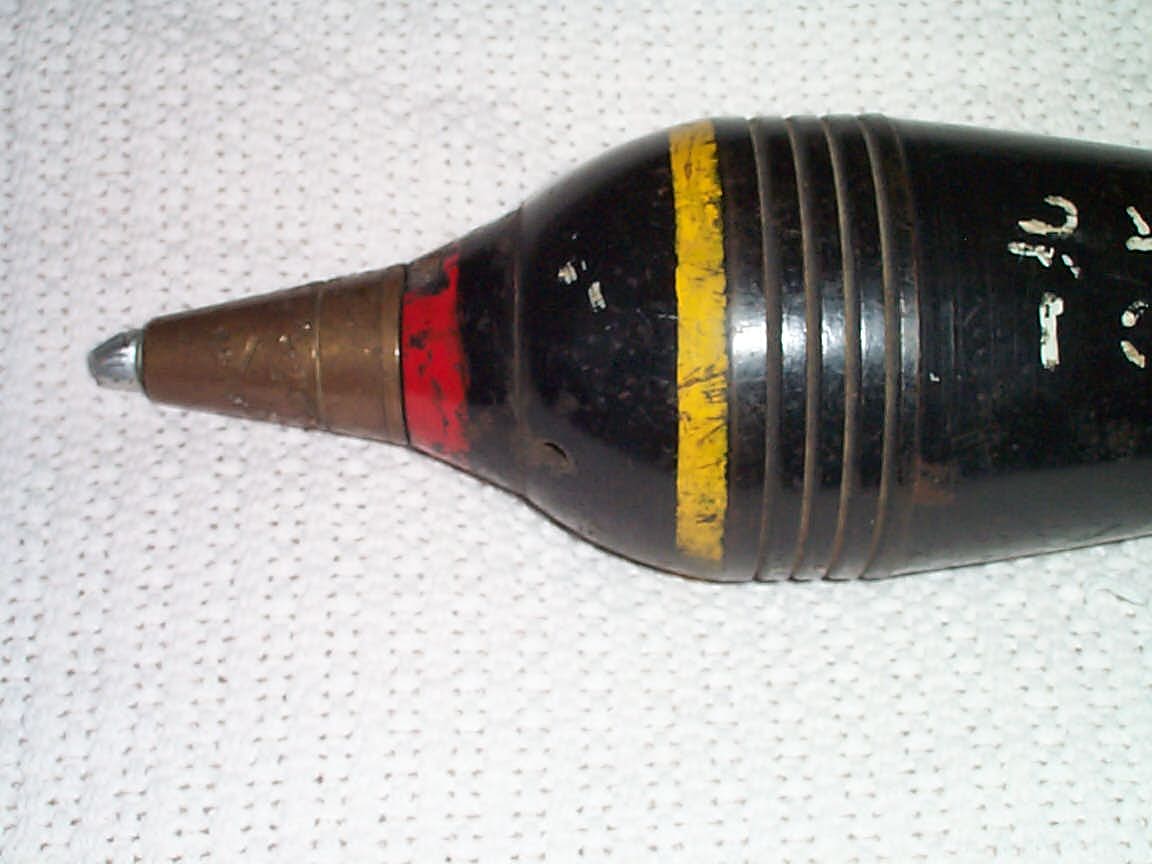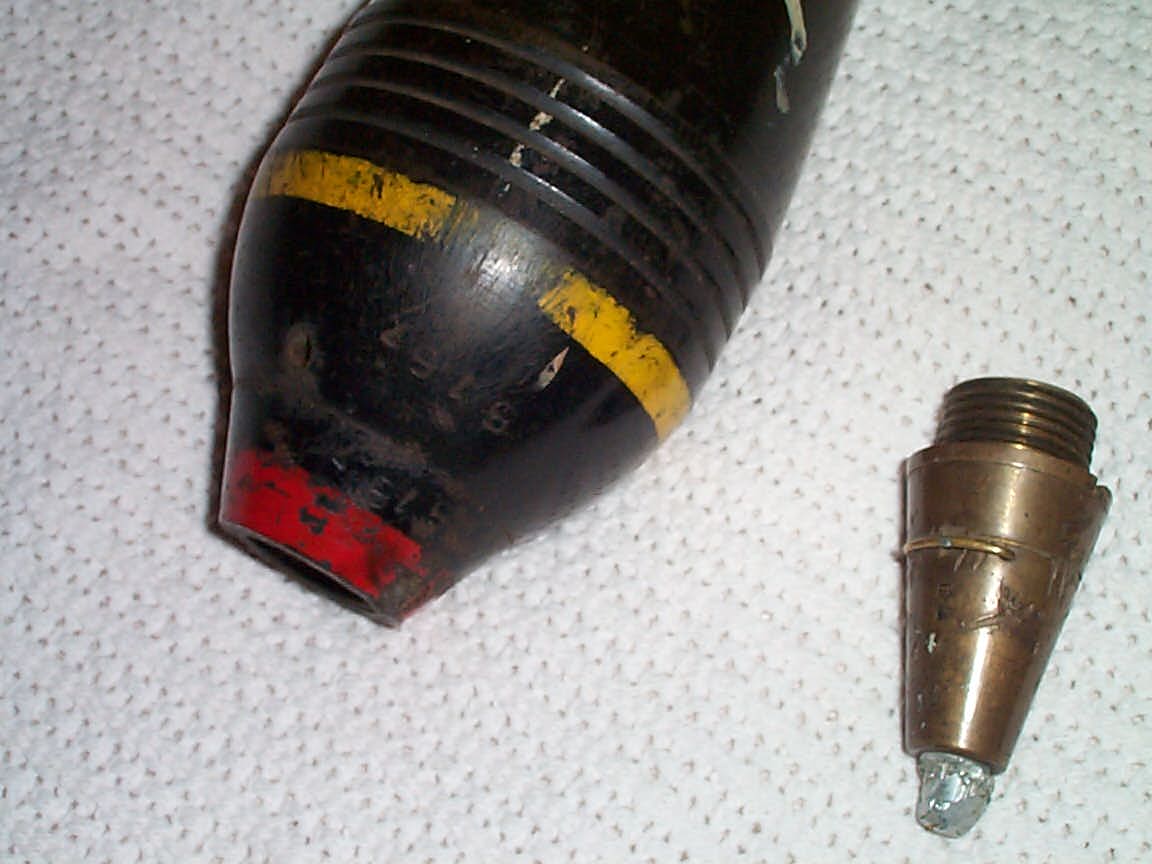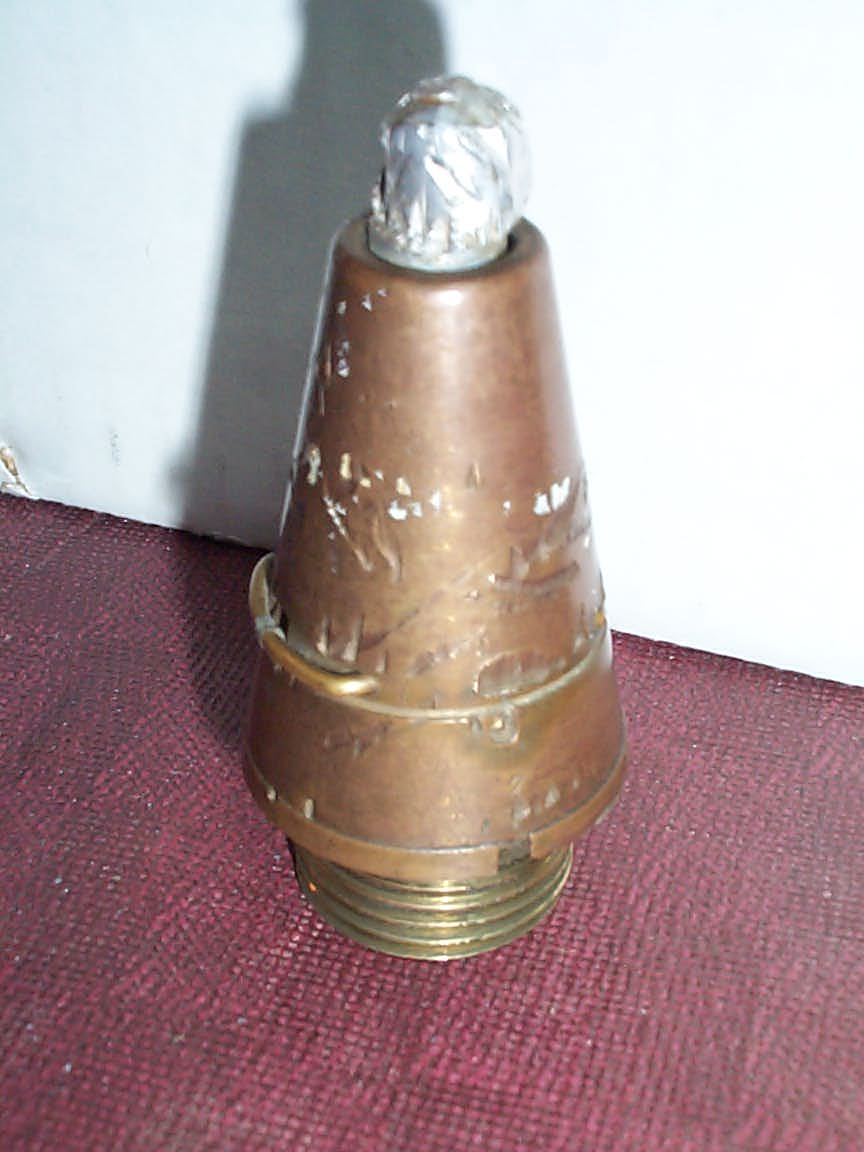I Have some Marine EOD Friends in Japan, Okinawa they Inert a lot of items I'll check to see if they can find anything on this item. but I was wondering about the mortar fuzes, I have an 81mm Japaneese mortar And it has a threaded adapter but I haven't been able to find a fuze for it.
British Ordnance Collectors Network
You are using an out of date browser. It may not display this or other websites correctly.
You should upgrade or use an alternative browser.
You should upgrade or use an alternative browser.
Japanese f headstamp
- Thread starter BOUGAINVILLE
- Start date
BOUGAINVILLE
Well-Known Member
Japanese 81mm mortar fuze
Hi there BOMBSaway, :tinysmile_shy_t:
I think that you will find that the 81mm mortar takes the Type 88 instantaneous fuse. My Japanese mortars certainly are fused with the Type 88 and in all of the information that I have on hand it is also the Type 88.
Cheers,
BOUGAINVILLE :tinysmile_shy_t:
Hi there BOMBSaway, :tinysmile_shy_t:
I think that you will find that the 81mm mortar takes the Type 88 instantaneous fuse. My Japanese mortars certainly are fused with the Type 88 and in all of the information that I have on hand it is also the Type 88.
Cheers,
BOUGAINVILLE :tinysmile_shy_t:
I Have some Marine EOD Friends in Japan, Okinawa they Inert a lot of items I'll check to see if they can find anything on this item. but I was wondering about the mortar fuzes, I have an 81mm Japaneese mortar And it has a threaded adapter but I haven't been able to find a fuze for it.
nice link Blu Thanks
Hi,
Nah, not so 'interesting' really; there is no evil plot behind it, nor an attempt to take credit for other people's work: I was on a long holiday and hadn't checked Bonnex files for weeks. I saw these docs on the NVBMB site and noticed them to be considerably more than I had seen in Bonnex's dir when I last checked. I had some time on my hands in the hotel's Internet set-up and decided to post the links, hoping someone could combine the two sets, and put them all in one public directory (see my remarks about that in the original post, as well as those in which I already mention that some of them will already have been posted). I guess I now know where the ones on the NVBMB site came from.
Either way: my post can either be ignored, or simply seen as a secondary location to retrieve those files: nothing more, nothing less. :tinysmile_cry_t2:
On a more interesting note, I have some two weeks now during which I hope to have some more time for ammo-fun stuff, so I shall see if I can find a good location for posting my docs on Jap ammo that include some substantially big titles (hundreds of MBs). I hope I can find a good spot for posting the big ones...
Cheers!
Olafo
I have just caught up with this thread and it's interesting to note that all of these files are identical to the originals listed by Bonnex at the link below.
http://www.mediafire.com/?sharekey=4...5965eaa7bc68bc
Nah, not so 'interesting' really; there is no evil plot behind it, nor an attempt to take credit for other people's work: I was on a long holiday and hadn't checked Bonnex files for weeks. I saw these docs on the NVBMB site and noticed them to be considerably more than I had seen in Bonnex's dir when I last checked. I had some time on my hands in the hotel's Internet set-up and decided to post the links, hoping someone could combine the two sets, and put them all in one public directory (see my remarks about that in the original post, as well as those in which I already mention that some of them will already have been posted). I guess I now know where the ones on the NVBMB site came from.
Either way: my post can either be ignored, or simply seen as a secondary location to retrieve those files: nothing more, nothing less. :tinysmile_cry_t2:
On a more interesting note, I have some two weeks now during which I hope to have some more time for ammo-fun stuff, so I shall see if I can find a good location for posting my docs on Jap ammo that include some substantially big titles (hundreds of MBs). I hope I can find a good spot for posting the big ones...
Cheers!
Olafo
Last edited:
Hi there BOMBSaway, :tinysmile_shy_t:
I think that you will find that the 81mm mortar takes the Type 88 instantaneous fuse. My Japanese mortars certainly are fused with the Type 88 and in all of the information that I have on hand it is also the Type 88.
Cheers,
BOUGAINVILLE :tinysmile_shy_t:
Hi guys,
sorry to be the bearer of bad news, but while the Type 88 fuzes (Instantaneous and Short Delay) will both fit into the 81mm, 90mm and 120mm mortars and are typically the most commonly seen in collections, neither is correct for any of these mortars. These fuzes each require rotation to arm, a force not provided by these fin-stabilised mortars. The correct fuzes are either the Type 93 Instantaneous or the Type 100 Instantaneous. I'll see if I can dig up some photos. JO
Hi,
While the explanation given by Jeff makes perfect sense, there's an odd thing. In OpNav 1667, in the section that treats the mortar rounds itself, the proper type of fuses is indeed mentioned to be Type 93 and Type 100 (no mention of Type 88 fuses), the entries on the fuses themselves may be somewhat confusing. The Type 93 fuse is properly listed as being a.o. for 'mortars', but for the Type 88, there's mention of there being a 'Gun' version and a 'Howitzer - mortar' version, which requires less set-back to move the arming collar backwards. No mention whatsoever here either about the Type 88 being suitable for mortar rounds...
Some theories as to why one may still see these fuses often on those mortar rounds:
-Perhaps such documentation, particularly the term 'Howitzer - mortar' , in combination with the fact that the fuse fits, may have been confusing for collectors putting them together from spare items.
-Or, perhaps a bolder explanation, could it perhaps be the case that the Type 88 fuse is much more ubiquitous, and that the Japanese have perhaps found a way to arm the fuses manually (though I don't see how they could easily arm then when requiring rotational force), and perhaps used those, by lack of the proper types?
Now, while candidate explanation #2 may sound ludicrous, and admitted, I don't see how they could arm a fuse requiring rotational force by hand, there is one thing that intrigues me. If you observe the attached pictures, you'll see an 81mm mortar round that I have incoming.
Now, the official story behind it, as it was told to me, this round is a WW2 vet bringback. Not only that, but according to the person (whom I've never spoken in person!), the round ricocheted off of a lava crop, and landed next to him. Again, according to that person, the damage you see on the fuse and the mortar body, is supposed to have been caused by this ricochet.
This story already sounded somewhat incredible to me, and your explanation on the fuses, in combination with the fact that this mortar round is equipped with a Type 88 fuse, most likely disproves this explanation. Also, the safety mechanism still seems to be in place, or is this of the kind that breaks up by the impact?
Anyway, it should be interesting to find out 100% for sure, but I too do assume that Jeff's explanation is the only correct one.
Cheers!
Olafo



While the explanation given by Jeff makes perfect sense, there's an odd thing. In OpNav 1667, in the section that treats the mortar rounds itself, the proper type of fuses is indeed mentioned to be Type 93 and Type 100 (no mention of Type 88 fuses), the entries on the fuses themselves may be somewhat confusing. The Type 93 fuse is properly listed as being a.o. for 'mortars', but for the Type 88, there's mention of there being a 'Gun' version and a 'Howitzer - mortar' version, which requires less set-back to move the arming collar backwards. No mention whatsoever here either about the Type 88 being suitable for mortar rounds...
Some theories as to why one may still see these fuses often on those mortar rounds:
-Perhaps such documentation, particularly the term 'Howitzer - mortar' , in combination with the fact that the fuse fits, may have been confusing for collectors putting them together from spare items.
-Or, perhaps a bolder explanation, could it perhaps be the case that the Type 88 fuse is much more ubiquitous, and that the Japanese have perhaps found a way to arm the fuses manually (though I don't see how they could easily arm then when requiring rotational force), and perhaps used those, by lack of the proper types?
Now, while candidate explanation #2 may sound ludicrous, and admitted, I don't see how they could arm a fuse requiring rotational force by hand, there is one thing that intrigues me. If you observe the attached pictures, you'll see an 81mm mortar round that I have incoming.
Now, the official story behind it, as it was told to me, this round is a WW2 vet bringback. Not only that, but according to the person (whom I've never spoken in person!), the round ricocheted off of a lava crop, and landed next to him. Again, according to that person, the damage you see on the fuse and the mortar body, is supposed to have been caused by this ricochet.
This story already sounded somewhat incredible to me, and your explanation on the fuses, in combination with the fact that this mortar round is equipped with a Type 88 fuse, most likely disproves this explanation. Also, the safety mechanism still seems to be in place, or is this of the kind that breaks up by the impact?
Anyway, it should be interesting to find out 100% for sure, but I too do assume that Jeff's explanation is the only correct one.
Cheers!
Olafo



Hi again,
As promised many a moon ago, please check the thread: http://www.bocn.co.uk/vbforum/japanese-ammo-documentation-t58885.html?t=58885
That thread contains links to all free documentation I have on Japanese ammo, and that AFAIK hasn't been linked to elsewhere here before.
Enjoy!
Olafo
As promised many a moon ago, please check the thread: http://www.bocn.co.uk/vbforum/japanese-ammo-documentation-t58885.html?t=58885
That thread contains links to all free documentation I have on Japanese ammo, and that AFAIK hasn't been linked to elsewhere here before.
Enjoy!
Olafo




